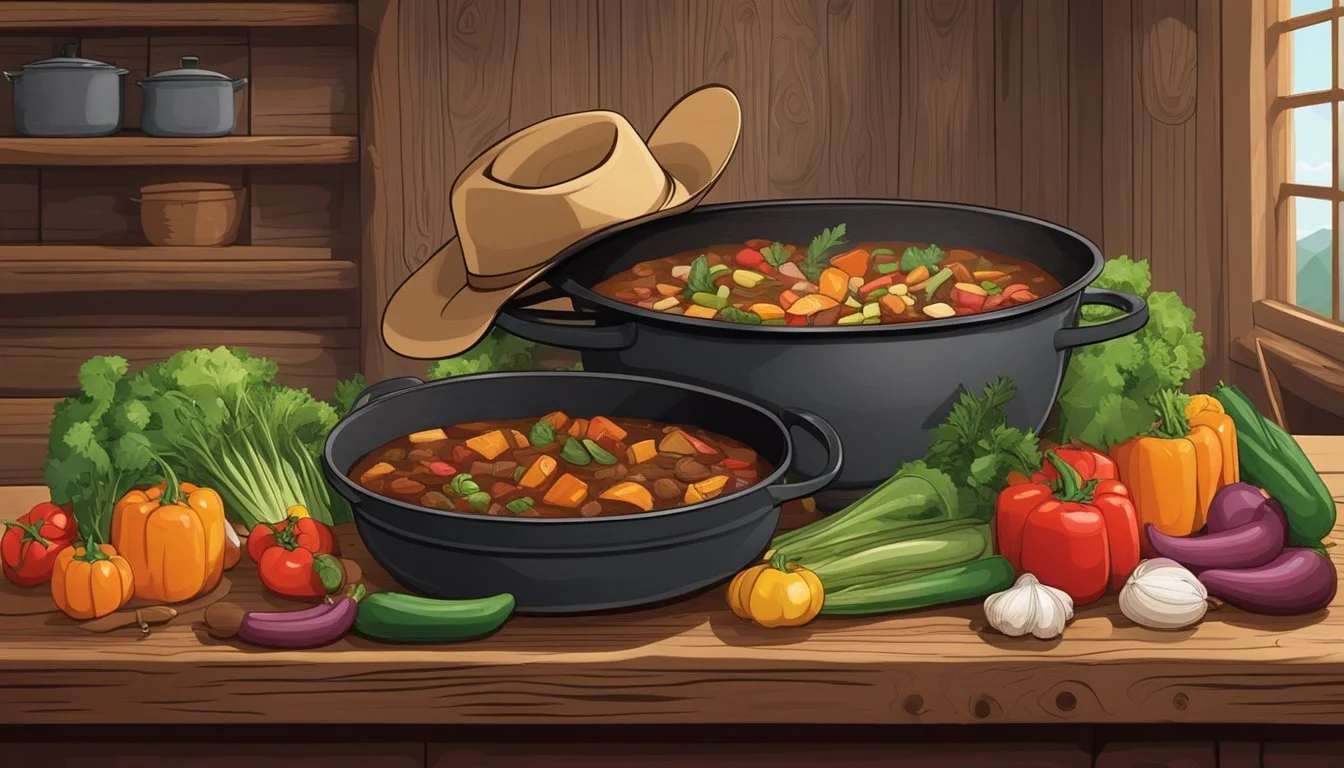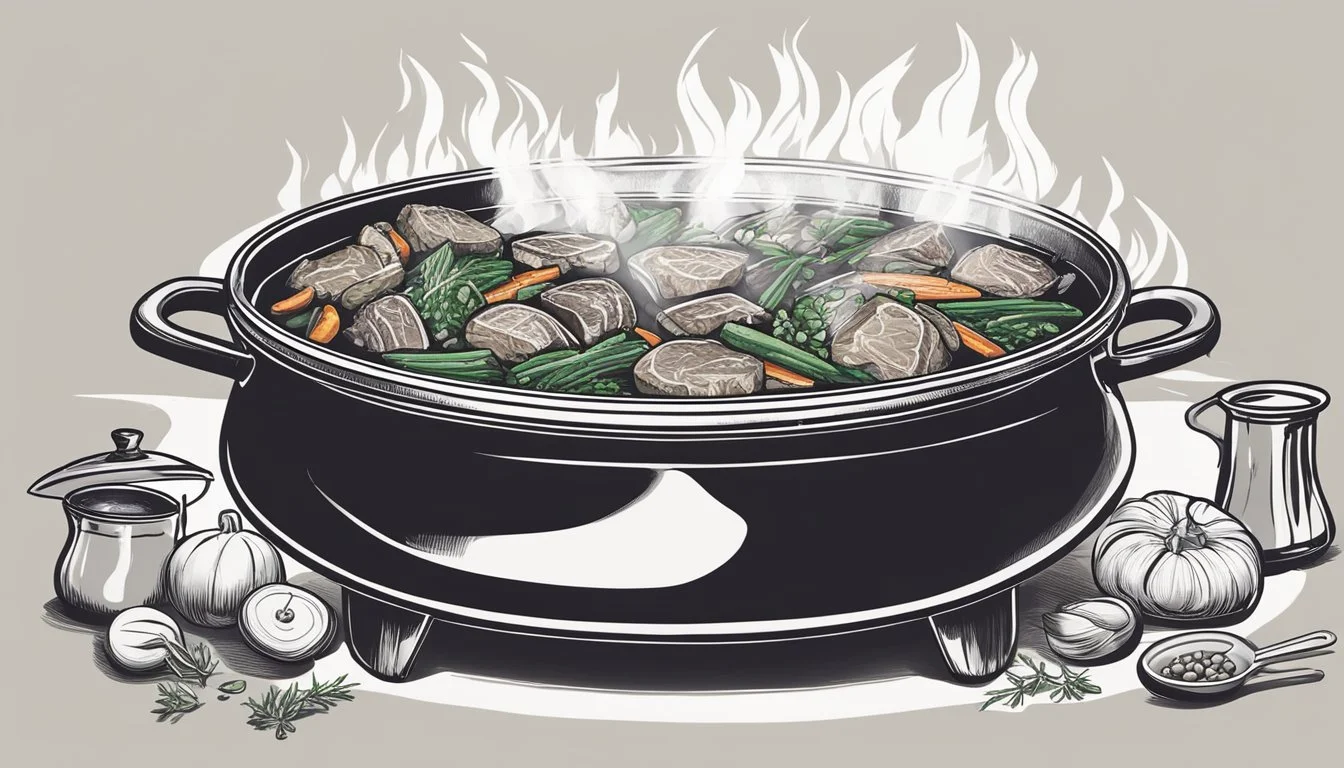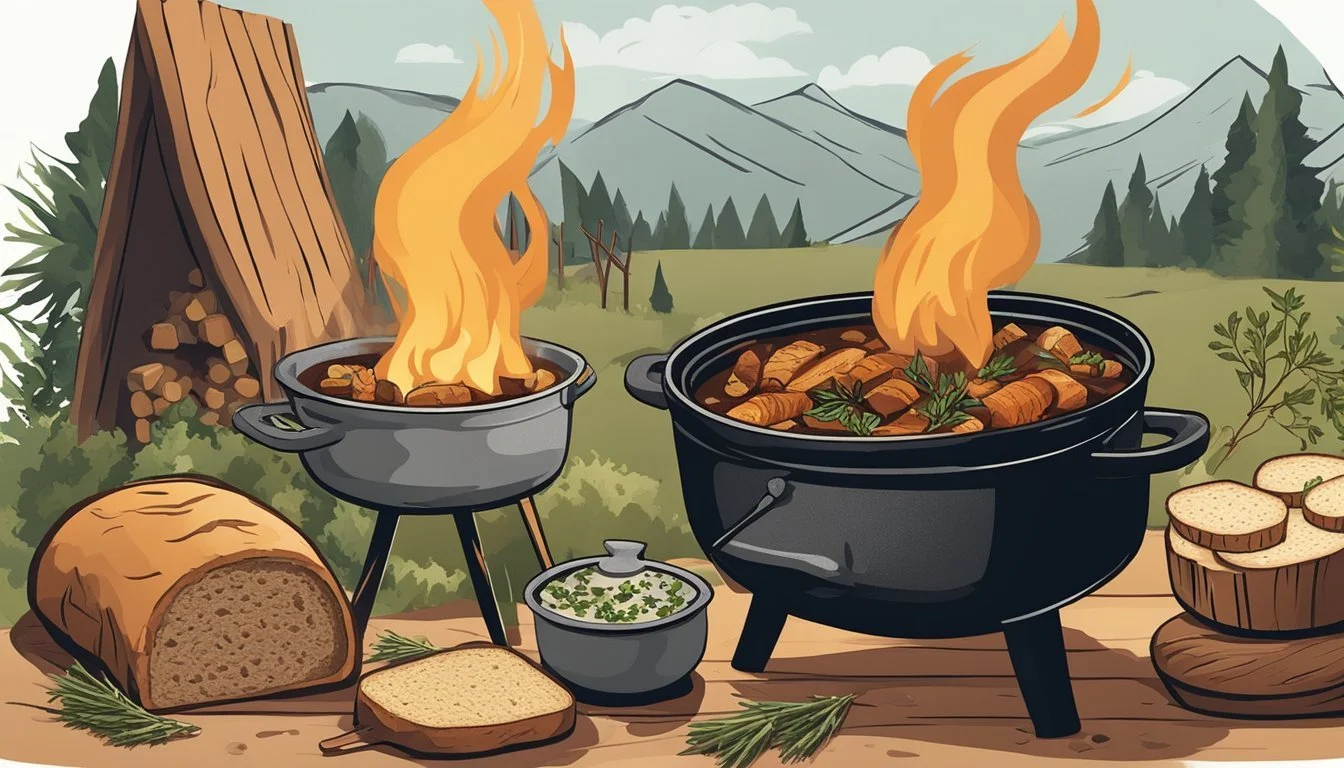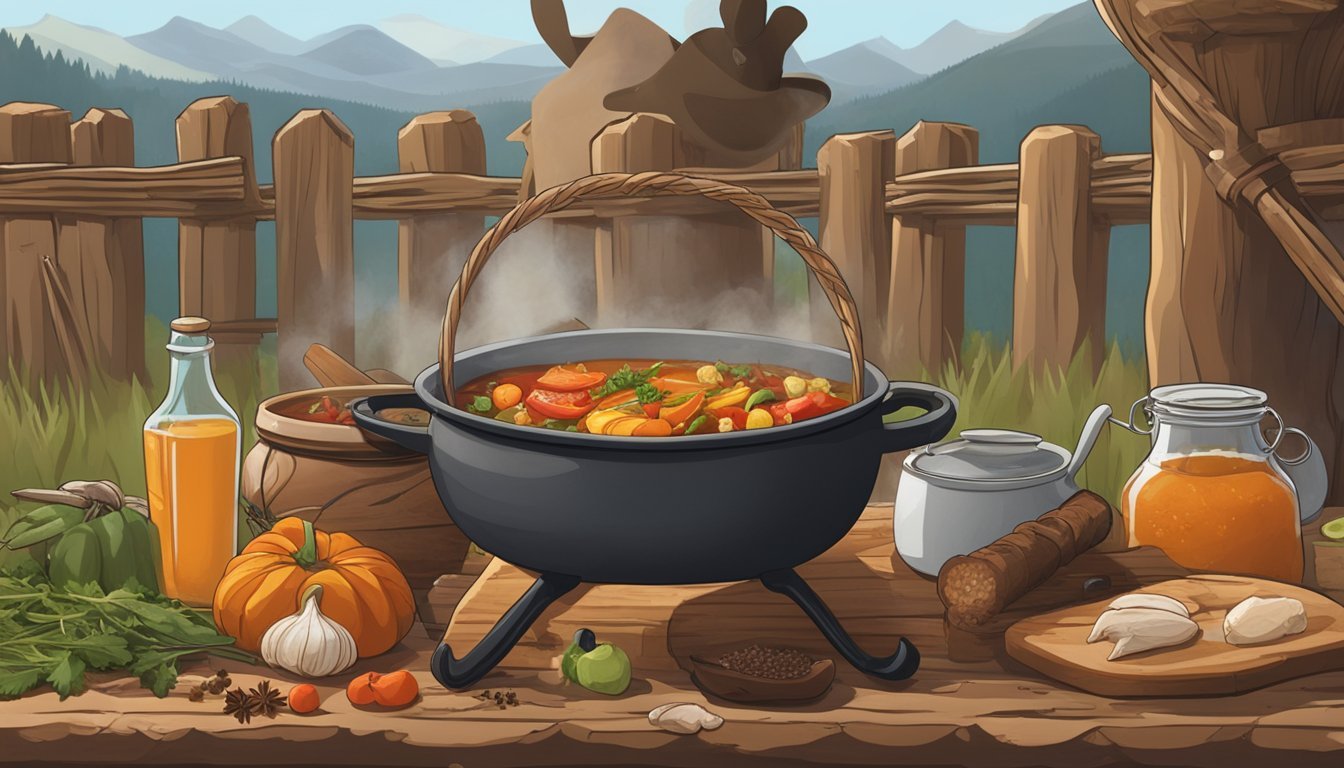A Taste of the Range
Authentic Cowboy Stew Recipes Unveiled
Cowboy stew is a hearty meal that embodies the spirit of the Old West, where rugged cowboys required robust sustenance after a long day of work. This traditional dish is a thick, rich concoction brimming with meat, vegetables, and potatoes, seasoned with a blend of spices to impart a comforting and savory flavor profile. The recipe has evolved over time, reflecting the resourcefulness of those who originally made it with whatever ingredients they had available.
The versatility of cowboy stew (What wine goes well with stews?) allows for a range of interpretations, with each recipe carrying the distinct mark of its creator. Beef often serves as the primary protein, though the inclusion of other meats like pork sausage is not uncommon. A variety of vegetables such as corn, beans, and diced tomatoes add texture and nutrition, making it a well-balanced one-pot meal.
Today, the dwelling on this culinary tradition goes beyond the frontier, finding its place in modern kitchens where the essence of cowboy cookery is celebrated. The stew is typically simmered over low heat, allowing the flavors to meld and intensify. This slow-cooking process is integral to achieving the depth of flavor that makes cowboy stew a beloved dish to many. Whether around a campfire or on the stovetop, this dish continues to be a testament to the simplicity and ingenuity of cowboy cuisine.
The Origins of Cowboy Stew
Cowboy Stew, often synonymous with Texas Cowboy Stew, traces its roots back to the rugged American frontier. It represents not just a recipe but a significant part of culinary history, embodying the essence of comfort food for the trailblazers of the Old West.
The central components of Cowboy Stew have remained consistent throughout its history:
A protein base, typically beef
Hardy vegetables
A rich, flavorful broth
The stew's creation was guided by necessity and practicality. Cowboys and cattle herders required a meal that could provide sustenance during long, arduous days. They often had limited ingredients at their disposal and needed to prepare food that could be easily cooked over an open flame.
Essential Influences and Method:
Protein: The protein, usually beef chunks, was made savory through seasoning and flour coating. It was then browned, an essential step to enrich the stew's flavor.
Vegetables and Broth: Common vegetables included potatoes and onions, which provided carbohydrates and nutrients. The mixture was cooked in a beef broth that would reduce down to concentrate the flavors.
Historical texts suggest that the stew's preparation varied, with each cowboy cook adding their twist depending on the available ingredients. Cowboy Stew was more than just a meal. It was a source of warmth and comfort at the end of a demanding day.
Reflecting the ingenuity of the cowboys, the stew has evolved yet preserved its identity as a cornerstone of cowboy cuisine. Its humble beginnings on the range have imparted a lasting legacy on Texas culinary traditions, making Cowboy Stew a perennial favorite for anyone seeking a taste of the Old West.
Key Ingredients for Authentic Flavor
The foundational elements of an authentic Cowboy Stew hinge on a robust selection of protein and vegetables. In the realm of proteins, beef stands out as a traditional choice, providing a hearty and rich taste. Bacon and kielbasa sausage are also popular for adding depth, with the smokiness of bacon and the distinctive flavor of kielbasa enhancing the stew's overall profile.
Beans represent another cornerstone ingredient. Varieties like pinto beans, kidney beans, and mixed vegetables often include corn, potatoes, onions, carrots, and green beans, forming a nutritious and flavorful base.
The stew wouldn't be complete without a harmonious blend of spices. Essentials such as chili powder, cumin, and smoked paprika lend a warm, earthy undertone while salt and black pepper are the go-to seasonings for balancing flavors.
Essential Vegetables & Proteins
Proteins Vegetables Beef Potatoes Kielbasa Sausage Onions Bacon Carrots Green Beans Mixed Vegetables
Key Spices for Authentic Cowboy Stew
Chili Powder: Adds a mild heat and complexity
Cumin: Contributes earthiness and a hint of citrus
Smoked Paprika: Infuses the stew with a smoky essence
Salt & Black Pepper: Elevates and balances the profile of flavors
To replicate the full-bodied taste that epitomizes Cowboy Stew, one must not overlook tomatoes. These not only add a slight tanginess but also enhance the stew's color and texture, ensuring that every spoonful is as visually appealing as it is delicious.
Spices and Seasonings Explained
The right blend of spices and seasonings is crucial to creating an authentic cowboy stew. Understanding how to balance these flavors and which herbs add the right depth can elevate the dish from good to great.
Balancing Flavor with Spices
Cowboy stew relies on a robust flavor profile where spices play a leading role.
Salt and Pepper: Fundamental to all cooking, salt enhances flavor, while black pepper adds a mild heat. They form the base of seasoning for cowboy stew.
Chili Powder: A key spice that offers a smoky flavor and varying levels of heat. It is essential for giving the stew its characteristic warmth.
Cumin: Earthy and slightly bitter, cumin compliments chili powder by adding depth and complexity to the stew.
Smoked Paprika: Imparts a rich, smoky undertone that echoes the open fires of the range.
Herbs for Aromatic Depth
While spices provide the base notes of the stew’s flavor, herbs bring an aromatic quality that completes the dish.
Garlic: More than a seasoning, garlic contributes a pungent, savoury element that is unmistakable in cowboy stew.
Cilantro: Often used as a garnish, cilantro can add a fresh, citrusy note that contrasts well with the heavy flavors of the stew.
Herbs: Select herbs such as oregano or thyme can be incorporated for their fragrant contribution that complements the rich, beefy components.
Cooking Methods for the Perfect Stew
When crafting the perfect cowboy stew, the cooking method plays a pivotal role in developing flavors and achieving tender textures. The choice of a slow cooker, Dutch oven, or stovetop influences the stew's taste and consistency.
Slow Cooker Technique
Using a slow cooker (or crockpot) allows for a gentle and consistent heat, leading to well-married flavors and tender beef. One begins by placing their seasoned meats and hardy vegetables into the slow cooker, followed by adding enough broth to cover the ingredients. The stew should cook on low heat for 6-8 hours or on high for 3-4 hours. The slow cooker's encapsulating warmth ensures flavors intensify over time.
Key Steps:
Layer ingredients and pour in the broth.
Set to low heat for deeper flavor or high for quicker cooking.
Dutch Oven Mastery
Preparing cowboy stew in a Dutch oven harnesses the benefits of even heat distribution and retention. It is critical to first brown meat directly in the pot to create a flavor foundation. Once browned, one adds broth and other stew components, covering the mixture and simmering on low heat for approximately 2 hours. The Dutch oven's thick walls facilitate a slow evaporation process, concentrating the stew's aroma and essence.
Essential Techniques:
Brown meats for a robust flavor.
Simmer and cover for a slow, flavor-enhancing cook.
Stovetop Simmering
The stovetop approach using a skillet or heavy pot offers the cook greater control over temperature adjustments. One should sear their meat for a flavorful crust before constructing layers of flavor with vegetables and spices followed by broth. The stew must then be brought to a gentle simmer and allowed to cook with the lid on, ensuring the potatoes become tender. The timeframe for stovetop simmering typically extends to around 20-40 minutes, depending on ingredient size and heat level.
Simmering Tips:
Sear meats before adding liquids.
Maintain a gentle simmer for consistent cooking.
Step-by-Step Cooking Guide
To create a hearty cowboy stew, begin by gathering the necessary ingredients: ground beef, sausage such as smoked sausage or kielbasa, bacon, onions, and additional vegetables and beans as desired.
Prepare the Meats:
Start by cooking bacon in a large pot until crisp. One should remove the bacon and set it aside, but keep a tablespoon of the grease in the pot for flavor.
Next, add onions to the pot and sauté until translucent.
Incorporate ground beef, breaking it apart and browning it thoroughly.
If using, slice sausage or kielbasa and add to the pot.
Combine Ingredients:
Once meats are properly cooked, one can proceed by adding the rest of the ingredients to the pot such as beans, corn, diced tomatoes, and potatoes if available.
Season the mixture with chili powder, cumin, salt, and pepper to taste.
Stir the ingredients together and then pour in enough beef broth to cover.
Bring the stew to a low simmer, cover the pot, and allow it to cook. The stew should simmer until the potatoes are tender, which typically takes 20-25 minutes.
Final Touches:
Return the cooked bacon to the pot and stir it into the stew for an added layer of flavor.
One may garnish the stew with parsley or any preferred herb before serving.
Throughout the process, the chef should ensure that the stew doesn't stick to the bottom of the pot, stirring occasionally. The stew is ready when the ingredients meld together, and the broth has thickened slightly.
Nutritional Information You Should Know
The nutritional content of cowboy stew is important for understanding the dish's impact on one's diet. It typically features a variety of ingredients that contribute to its overall nutritional value, including proteins, vegetables, and starches.
Caloric and Macronutrient Breakdown
Cowboy stew is rich in macronutrients due to its diverse ingredients. The average serving can range significantly in calories, primarily depending on the amounts and types of meat used, as well as the cooking method.
Calories: An average bowl of cowboy stew can contain between 300 to 500 calories.
Fat: It typically contains fat from meats such as ground beef and sausage, with a range of 10 to 20 grams per serving, including some saturated fat.
Carbohydrates: The presence of beans, potatoes, and corn constitutes the stew's main carbohydrate sources, contributing approximately 30 to 50 grams per serving.
Sugar: Minimal unless sugar is added for taste; mainly from the natural sugars present in the tomatoes and vegetables.
Fiber: Beans and vegetables add fiber to the stew, providing about 5 to 10 grams per bowl.
Protein: Ample amounts are present from the meats, with an average of 20 to 40 grams per serving.
For those monitoring cholesterol and sodium, the content can be significant due to processed meats and added salt. Adjustments can be made by choosing leaner cuts of meat and reducing sodium levels.
Understanding Vitamins and Minerals
The ingredients in cowboy stew also contribute essential vitamins and minerals to one's diet. These micronutrients play vital roles in maintaining health and should not be overlooked.
Iron: Red meat and beans offer a good source of iron, important for blood health.
Vitamins: Vegetables like tomatoes and bell peppers add vitamins A and C, while potatoes provide vitamin C and B vitamins.
Minerals: Alongside iron, the dish contains other minerals such as potassium and magnesium.
By including a range of vegetables, cowboy stew can become a more balanced and vitamin-rich meal. However, individuals with specific dietary requirements or restrictions should consider the stew's components carefully, especially in terms of sodium and saturated fat content.
Serving and Pairing Suggestions
Cowboy stew is a hearty meal that can be enhanced with the right sides and drinks. The selections presented here aim to complement the robust flavors of the stew and to elevate the dining experience.
Suitable Sides and Accompaniments
Pairing cowboy stew with suitable sides can turn it into a memorable feast. For a traditional touch, cornbread or cornbread muffins make an excellent choice, offering a slightly sweet counterbalance to the savory stew. A more indulgent option involves serving the stew with a side of garlic bread or cheesy biscuits, which can be used to sop up the flavorful broth. For those seeking a lighter accompaniment, a crisp side salad dressed with a tangy vinaigrette can offer a refreshing contrast.
Bread Options:
Cornbread
Cornbread Muffins
Garlic Bread
Cheesy Biscuits
Lighter Options:
Green Salad with Vinaigrette
Wine and Beverage Pairings
The robust flavors of cowboy stew call for beverages that can stand up to its hearty nature. A full-bodied red wine such as a Zinfandel or Syrah pairs well, enhancing the earthy elements of the beef and spices. For those who prefer beer, an amber ale or stout complements the richness of the stew without overwhelming the palate. Non-alcoholic options include unsweetened iced tea or lemonade, offering a refreshing counterpoint to the dish.
Wine Options:
Zinfandel
Syrah
Beer Options:
Amber Ale
Stout
Non-Alcoholic Options:
Iced Tea
Lemonade
Storing and Preserving Cowboy Stew
Proper storage techniques are crucial for maintaining the freshness and flavor of Cowboy Stew. By following these guidelines, one can ensure their leftovers stay safe and tasty for future meals.
Refrigeration Tips
After cooling the Cowboy Stew to room temperature, it should be placed in an airtight container. This limits exposure to air, preventing bacteria growth and preserving the quality of the stew. One should transfer the stew to the refrigerator within two hours of cooking to ensure safety. The stew can be safely stored in the refrigerator for 3 to 4 days.
Cooling Down: Allow stew to reach room temperature.
Transferring: Place stew in an airtight container.
Refrigeration: Store in the refrigerator within two hours.
Duration: Keep for 3 to 4 days.
Freezing and Reheating Best Practices
For longer storage, freezing the stew is the best option. One should portion the stew into servings and store each in an airtight container or freezer bag. When freezing, ensure that all air has been removed to prevent freezer burn. Cowboy Stew can be frozen for up to 2 months. To thaw, place in the refrigerator overnight or use a microwave's defrost setting. For reheating, ensure the stew is heated thoroughly to at least 165°F to guarantee food safety.
Portioning: Divide the stew into individual servings.
Freezing: Use airtight containers or freezer bags, removing as much air as possible.
Storage Duration: Can be frozen for up to 2 months.
Thawing: Thaw in the refrigerator or use a microwave's defrost function.
Reheating: Heat to a minimum of 165°F before serving.
Customizing Your Stew to Taste
When creating an authentic cowboy stew, one has the flexibility to personalize the flavor profile to meet individual tastes. The key is to balance the hearty components with spices and seasonings that complement each other.
Choosing Potatoes: For texture, russet potatoes are an excellent choice due to their starchy quality, which helps thicken the stew. Alternatively, Yukon golds lend a buttery flavor and hold their shape well in the cooking process.
Meat Variations: Traditional recipes often use beef as the primary protein. However, pork can be substituted for a different flavor, or even hot dogs for a simpler, family-friendly option. It is critical to cook the meat until it is no longer pink to ensure both safety and tenderness.
Beans and Corn: Baked beans add a sweet and tangy dimension, while sweet corn introduces a delightful crunch and natural sweetness. They contribute to the stew’s hearty characteristic, making it a fulfilling meal.
Spice Adjustments: For those who favor a spicy kick, incorporating chili powder or cayenne pepper can elevate the heat level. For a milder dish, these can be reduced or omitted entirely.
Broth and Cream:
Beef broth serves as the stew's robust foundation, deepening the meaty flavors.
A dollop of sour cream can be swirled in before serving to add a tangy creaminess that contrasts with the rich base.
Managing Sweetness: Careful attention should be given to balancing sweetness. If the stew leans too sweet due to baked beans or corn, a small amount of sugar can be reduced, or acidity can be increased with a splash of tomato sauce or vinegar.
Remember that personal preference plays a significant role. Bold or subtle, the taste of cowboy stew can be tailored to be as unique as the individual preparing it.
Frequently Asked Questions
What defines a cowboy stew recipe? A cowboy stew combines a heaping mix of protein like smoked sausage or ground beef, starchy veggies, hearty beans, and a tomato-based broth. It's a family favorite because it's not only satisfying but also versatile, allowing for different meats and veggies to be used.
What ingredients do I need for an authentic cowboy stew? Typical ingredients include:
Meats: smoked sausage, bacon, ground beef
Veggies: onion (cooked until translucent), corn, tomatoes, potatoes
Flavor enhancers: minced garlic, chili powder, cumin
Liquids: beef broth or water
How do I make the onion translucent for the stew? Cook the onion in a pan over medium heat, stirring occasionally, until it becomes soft and clear, about 5 to 7 minutes.
Can I add other veggies to my cowboy stew? Absolutely. Cowboy stew is adaptable. Common additions include bell peppers, carrots, and celery.
Ingredients Preparation Onion Cook until translucent Minced garlic Cook for 1 minute after onions Other veggies Add according to personal taste
What makes cowboy stew a satisfying meal for the whole family? Its rich flavors, hearty ingredients, and the ability to customize based on personal preferences make it a satisfying meal that appeals to a variety of tastes, making it a family favorite.
Tips and Tricks for the Perfect Stew
To craft an authentic cowboy stew that's rich in taste and hearty in texture, one needs to pay attention to the stew's consistency and the method of enhancing the flavor profile over time. These elements are crucial for achieving that comforting bowl that's synonymous with cowboy cuisine.
Achieving the Right Consistency
In cowboy stew, the consistency is as important as the flavor. A perfect stew should be neither too thick nor too thin. Achieving this balance begins with choosing the correct base ingredients:
Lean Ground Beef: Provides a substantial texture without excess fat.
Beans: Black beans and other legumes contribute to the stew's thickness and are a source of protein.
Corn: Adds a natural thickness and a subtle sweetness to the mixture.
Diced Tomatoes: Offer both liquid and bulk, creating a well-rounded consistency.
Here's a quick guide on steps to maintain that perfect stew consistency:
Brown the lean ground beef thoroughly, ensuring it’s completely cooked before adding liquids.
Combine beans and corn early in the cooking process, as these will help to naturally thicken the stew.
Incorporate diced tomatoes with their juices to add more body to the broth.
Monitor the stew as it simmers, adding broth incrementally if the stew becomes too thick.
Enhancing the Stew Over Time
Allowing flavors to meld and mature can transform a good stew into a great one. The slow cooker is an excellent tool for this process, enabling a gentle and controlled simmer that thoroughly infuses flavors:
Spices: Add spices such as chili powder, cumin, and smoked paprika early on so they can permeate the entire stew.
Smoked Sausage: Incorporating smoked sausage not only adds a layer of flavor but also infuses the entire stew with its aroma.
Simmering: Cook the stew in a slow cooker on low heat for several hours to allow the meat and vegetables to tenderize and the flavors to deepen.
Here's a practical approach to flavor enhancement over time:
Add spices immediately after browning the meat to coat it in the spice mixture.
Cut smoked sausage into slices or chunks and add it to the slow cooker, ensuring its smoky flavor spreads throughout the stew.
Allow the stew to simmer in the slow cooker for at least 4 hours, checking occasionally and adjusting the seasoning as needed.
Remember, patience is key. The slow simmer of a cowboy stew is what allows its rich tapestry of flavors to develop fully.








